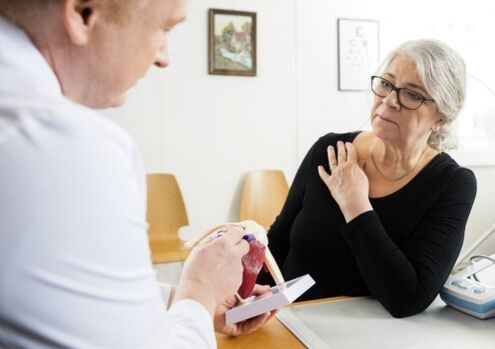The pain on the left under the shoulder blade makes a suspicious person immediately think of a heart attack. Of course, don't forget about this life-threatening condition, but back and left pain are more common for less dangerous reasons. It is worthwhile to familiarize yourself with why there is pain under the left shoulder blade from behind, to know which doctor to seek help and when to call an ambulance.
1. Intercostal neuralgia
The disease is accompanied by inflammation of the nervous processes.
causes
Provokes nerve irritation:
- Hypothermia;
- Herpes infections;
- Injuries to the ribs or spine;
- Injury to the nerve root with thoracic osteochondrosis;
- diseases associated with deformation of the chest (spondylosis);
- benign neoplasms of the pleura;
- allergic reaction;
- Osteochondrosis.
Suddenly, neuralgia pain appears under the shoulder blade on the left, scaring a person, which leads them to suspect the worst.
Symptoms
With intercostal neuralgia, the pain is painful, and the intensity depends on the severity of the pathology. The pain can be severe, almost unbearable, or the disease manifests itself in mild painful discomfort.
Typical symptoms that indicate inflammation or irritation of the nerve processes include:
- Connection with movement and breathing. The pain under the shoulder blade starts to hurt more when you move your left hand, cough, take sharp breaths, or laugh.
- The influence of heat. After rewarming, the pain will decrease or go away completely.
- Scan. It hurts more when you push it.
If the cause is a herpes infection, the patient will develop characteristic rashes along the nerves.
In addition to pain, a person can experience:
- Tachycardia;
- Numbness of the skin;
- increased sweating.
It is not always possible to determine whether the pain under the left shoulder blade is caused by intercostal neuralgia or cardiac pathologies. If the pain syndrome has appeared for the first time and there is no certainty that it is painful from irritation of the nerve processes, you should see a doctor immediately.

treatment
Therapy for intercostal neuralgia depends on the cause of the disease.
Patients are prescribed:
- antiviral drugs and ointments (for herpes);
- Painkiller;
- Non-steroidal anti-inflammatory drugs;
- Ointments with a warming effect.
If the disease is accompanied by severe pain under the left shoulder blade that cannot be stopped by taking analgesics, patients are given a novocaine block for relief.
In the subacute stage, to improve tissue trophism and shorten the recovery period, the following are used:
- physiotherapeutic procedures;
- Massage;
- Acupuncture.
Treatment is aimed not only at relieving back pain under the left shoulder blade, but also at treating a provocative disease (osteochondrosis, herpes). If this does not happen, the pathology becomes chronic, exacerbated by hypothermia or physical exertion.
Who to contact
If there is pain in the left shoulder blade area and there is no suspicion of heart disease, you need to see a neurologist.
2. Diseases of the bronchopulmonary system
A disease of the lower respiratory tract (bronchi, lungs, pleura) can cause pain in the left shoulder blade from behind.
causes
The main cause of pain in respiratory diseases is diseases caused by pathogenic bacteria and viruses:
- Bronchitis;
- Lung infection;
- Pleurisy.
Back pain on the left side can also occur due to the appearance of neoplasms in the bronchi or lungs.
Symptoms
A person has a constant pulling or sore pain under the left shoulder blade. When you cough and breathe deeply, the pain increases. In addition to painful sensations in the left back, patients may present with the following ailments:
- Fever, which sometimes reaches high numbers;
- dry cough or with a viscous sputum (there may be streaks of blood or an admixture of pus in the mucus discharge);
- Weakness and apathy;
- Difficulty breathing.
If the back pain on the left under the shoulder blade leads to tumors, there is no hyperthermia, coughing and breathing difficulties become additional symptoms.
treatment
If the inflammatory process provokes back pain and signs of inflammation, then patients are prescribed:
- Antibiotics or antivirals;
- Drugs to liquefy and stimulate the expectoration of sputum;
- antipyretic drugs;
- Pain relievers (if it starts to hurt a lot).
For neoplasms, treatment depends on the type and size of the tumor. Patients are removed tumor formation or conservative therapy.
Who heals
Inflammatory processes in the bronchi or lungs are treated by a pulmonologist, and with neoplasia you need to see an oncologist or surgeon.
3. Vegetovascular crises
The patient complains of pulling pain in the left side under the shoulder blade and a feeling of anxiety, but no pain relievers can be found at the initial examination.
causes
Crises can pass on their own, and due to the lack of signs of organic pathology, such people are considered hysterical and unrestrained. But in reality, crises cause:
- hormonal imbalance;
- neurological pathology;
- emphasize;
- psycho-emotional overload;
- endocrine diseases;
- long-term use of antidepressants or psychotropic drugs.
Vegetative crises are often the first sign of neurological disorders. After strong experiences or shocks, signs of deterioration in well-being and painful discomfort appear under the left shoulder blade. Most often children and women under 30 years of age suffer from the disease.

Symptoms
In the case of a vegetative-vascular crisis, not only does pain occur on the left under the shoulder blade, but the patient can also experience:
- a feeling of suffocation;
- Cardiopalmus;
- Tremors in arms and legs;
- baseless fear;
- feeling hot or cool;
- Sweat;
- A headache;
- Loss of consciousness.
It is characteristic that patients cannot state exactly where it hurts. Not only does pain occur under the shoulder blade, but also under the ribs, there is often radiation from the left shoulder, arm or abdomen.
The duration of a crisis varies from a few minutes to an hour and a half. In severe cases, a person has seizures.
Another danger is fear of attack. A person is afraid of unpleasant sensations, tries to follow all kinds of rituals in order to avoid pain under the shoulder blade and other unpleasant symptoms. Without treatment, the condition turns into a phobia.
treatment
The presence of seizures is an indication of immediate hospitalization; lighter forms of vegetative vascular crisis are treated at home. They are used as therapy:
- Sedatives for severe anxiety;
- herbal remedies for calming down;
- Antidepressants to reduce increased nervousness and anxiety.
If crises are caused by neurological or endocrine diseases, additional therapy is chosen to eliminate the disorders that have arisen.
If the onset of an attack is associated with a stressor, additional training is provided to patients in how to respond appropriately to stressful situations and it is recommended to avoid overwork.
Which doctor should you contact?
When panic attacks occur, you need to contact a vegetarian, but not all cities have these specialists. If advice from a vegetarian is not possible, you should consult a neurologist or therapist. In addition, you may need to consult an endocrinologist.
4. Myocardial Infarction
A life-threatening condition caused by acute ischemia and necrosis of the heart muscle. In this case, the pain under the shoulder blade and behind the sternum is severe.
Provoking factors
The reasons for such pain under the shoulder blade on the left from the rear lie in the complete cessation of coronary blood flow to a certain part of the myocardium, caused by an obstruction of the vessel. The following pathologies can provoke a heart attack:
- Arteriosclerosis;
- Thrombosis.
The resulting blood clot or plaque breaks off and blood flows to the heart. Once in the small-diameter coronary arteries, they occlude the vessel lumen and stop the flow of blood to the tissues. Lack of oxygen leads to the death of heart muscle cells.
Symptoms
The pain is acute and throbbing, localized to the left behind the sternum. Irradiated:
- in the left hand;
- under the shoulder blade;
- in the lower jaw.
In the case of an atypical course of a heart attack, radiation is possible:
- in the epigastric region;
- in the right back;
- in the lower abdomen.
In the event of a heart attack, the pain behind the shoulder blade is not relieved by taking analgesics and is slightly reduced after taking nitroglycerin.

treatment
Therapy is aimed at removing obstacles in blood flow, reducing the focus of myocardial necrosis, and eliminating pain. Apply for it:
- Agents that dissolve blood;
- Medicines that thin the blood;
- narcotic analgesics;
- Drugs to improve vascular tone.
Other drugs are selected taking into account the violations that have occurred - these may be drugs to lower cholesterol, antihypertensive drugs with high blood pressure, etc.
In the first few hours, surgical angioplasty can be performed to reduce the necrosis. Surgical intervention can quickly restore the circulatory disorder and reduce the post-infarct scar.
Which doctor treats
In the event of a heart attack, emergency hospitalization is indicated in the cardiology department, where ventilators and cardiologists select an effective therapy. If you suspect a heart attack, you should call an ambulance immediately.
5 more reasons why the back under the shoulder blade can hurt behind it
Think about why it can hurt under the left shoulder blade from behind:
- Angina pectoris. Brief spasm of the coronary arteries due to stress or physical exertion. There is sharp pain in the back left under the shoulder blade and behind the sternum, which disappears after taking drugs with nitroglycerin.
- Osteochondrosis or hernia of the chest region. If the nerve root is pinched, a diffuse pain arises in the back to the left under the shoulder blade, which increases with movement.
- Stomach ulcers. The pain occurs not only behind the shoulder blade, but also in the upper abdomen. It starts to hurt more after eating or when you are hungry for a long time. There are also heartburn, uncomfortable belching, nausea. Pain symptoms are slightly reduced after vomiting.
- Disease of the pancreas or spleen. With these pathologies, the left side hurts in the area of the shoulder blade and ribs. In acute pancreatitis, not only does the back hurt, but girdle pain also occurs, covering the left and right hypochondria.
- Injuries. Back injuries to the left in the area of the shoulder blade can cause irritation of the nerve processes and the pain syndrome can recur several weeks after the injury with increased physical exertion or hypothermia.
If there is pain under the left shoulder blade from behind, this condition should not be ignored, even if the pain is mild. Painful discomfort can be caused by a life-threatening condition.
What to do if you have pain in your back, below the left shoulder blade?
If pain syndrome occurs from behind under the left shoulder blade, there is no need to panic, but there is no need to ignore the condition that has occurred. Before deciding which doctor to go to, you should try to find out what exactly is hurting from the back left, under the shoulder blade. To do this, you need to determine additional pain characteristics:
- Localization. If there is pain in the back below the left shoulder blade and the painful discomfort increases after eating or during prolonged fasting, the likelihood of heart disease is minimal.
- Intensity. Moderate pain syndrome often accompanies chronic diseases, but severe pain indicates a severe pathological process.
- Character. Acute pain requires immediate medical attention, and if you have pulling or painful pain, you must go to the clinic.
- Connection with movement and breathing. If the pain becomes more severe when you cough, lean forward, or try to move your left hand, it suggests spinal disorder or intercostal neuralgia.
Back pain under the left shoulder blade has various causes and is not always harmless to life and health. The newly emerging pain syndrome on the left under the shoulder blade requires special attention - this can be a sign of neuralgia, angina pectoris, or even a heart attack. If there is any doubt about the origin of the pain syndrome, you need to call an ambulance. Getting medical attention early can help maintain health and sometimes save lives.

















































